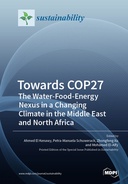Explore

Towards COP27: The Water-Food-Energy Nexus in a Changing Climate in the Middle East and North Africa
0 Ungluers have
Faved this Work
Login to Fave
Due to its low adaptability to climate change, the MENA region has become a "hot spot". Water scarcity, extreme heat, drought, and crop failure will worsen as the region becomes more urbanized and industrialized. Both water and food scarcity are made worse by civil wars, terrorism, and political and social unrest. It is unclear how climate change will affect the MENA water–food–energy nexus. All of these concerns need to be empirically evaluated and quantified for a full climate change assessment in the region. Policymakers in the MENA region need to be aware of this interconnection between population growth, rapid urbanization, food safety, climate change, and the global goal of lowering greenhouse gas emissions (as planned in COP27). Researchers from a wide range of disciplines have come together in this SI to investigate the connections between water, food, energy, and climate in the region. By assessing the impacts of climate change on hydrological processes, natural disasters, water supply, energy production and demand, and environmental impacts in the region, this SI will aid in implementation of sustainable solutions to these challenges across multiple spatial scales.
This book is included in DOAB.
Why read this book? Have your say.
You must be logged in to comment.
Rights Information
Are you the author or publisher of this work? If so, you can claim it as yours by registering as an Unglue.it rights holder.Downloads
This work has been downloaded 69 times via unglue.it ebook links.
- 69 - pdf (CC BY) at Unglue.it.
Keywords
- activated carbon
- active methods
- adsorption
- adsorptive membrane
- AHP
- analytical hierarchical process (ahp)
- Aquaculture
- Arabian peninsula
- Archimedes optimization algorithm
- arid areas
- assessment
- biochar
- biocompatible nanogold
- biogas
- Carbon sequestration
- CFD
- Climate Change
- CO2 absorption
- cogeneration systems
- croplands and rangelands
- CROPWAT model
- decolorization
- direct red-81
- drought
- dye removal
- Egypt
- electronics cooling
- Émissions
- energy hub
- enthalpy-porosity method
- externality costing
- Flood
- GAIA dataset
- geospatial analysis
- geospatial technique
- GIS
- gold nanoparticles
- Graphene
- green capping agent
- Greenhouse gases
- groundwater salinization
- groundwater vulnerability
- hazards
- heat transfer enhancement
- helical rotating shaft
- high-heat devices
- hybrid membrane
- hydrologic modeling
- hydrology
- inserts
- instant nanosynthesis
- inundation
- ion ratios
- irrigation water requirements
- Land surface temperature
- landfill of Mohammedia
- Mann–Kendall test
- Mathematics & science
- MEA
- melting PCM
- membrane
- membrane contactor
- Methane
- methylene blue
- metrologic analysis
- microchannels
- Middle East
- modeling
- modified DRASTIC-LU
- MODIS
- multi-block pricing
- mushy zone parameter
- natural convection
- Nile Delta
- Nile Delta region
- nitrate reductases
- northwest coast
- Numerical Simulation
- operating parameters
- organic manures
- plate heat exchanger
- pore size
- porosity
- protection structures
- rainfall anomaly index
- rainwater harvesting
- Remote sensing
- sand and dust storms
- seawater mixing index (SMI)
- shoreline changes
- single-block pricing
- soil conservation service-curve number
- solar concentrator
- spatial-temporal analysis
- Stable isotopes
- standard precipitation index
- surface and ground water changes
- sustainability
- sustainable
- Theil–Sen estimator
- thema EDItEUR::P Mathematics and Science
- thematic layers
- thermal
- thermal management
- turbulent flow
- upgrading
- urban bias
- urban infrastructure
- urban warming
- urchin-shaped nanogold
- water management
- water pricing
- weighted overlay model
- zero-valent iron
Links
DOI: 10.3390/books978-3-0365-6584-2Editions

